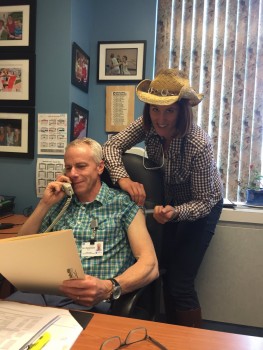Paediatricians and social media: Why it’s time to join the conversation
Posted on December 1, 2017 by the Canadian Paediatric Society | Permalink
Topic(s): Advocacy, Public education
With the rise of technology, children and teens are now creating and sharing information at a dizzying pace. Text messages, Facebook, Twitter, Instagram, Snapchat, YouTube, and blogs are essential elements of their days.
Feel like a dinosaur yet?
If so, you are not alone. In fact, about half of all Canadians are not on social media. The likes of Facebook, Twitter, and increasingly, Instagram, tend to favour the 18 to 29 crowd.
Are you still on the fence about joining social media? CPS President Dr. Mike Dickinson has embraced his new role as a “tweetiatrician,” and feels it’s important for other doctors to do the same.
Forges connections
Many people say one of the most important reasons to join a social network is to stay connected with others who share similar interests.
Dr. Dickinson said being on Twitter has allowed him to connect with other professionals in the child health space who are active in advocacy and health promotion.
“It is helpful for me, living in a rural location, to be easily connected with other kindred spirits and to just stay in the loop about what’s going on in the child health world,” he said.
Brings the news to you
When you’re on social media, particularly Twitter, you don’t have to seek out the news. The news finds you.
Dr. Dickinson said that if you follow the right people, you can filter information so that the news you see is high quality and relevant. “I don’t have to skim whole journals, whole editions of the Globe and Mail to find the nuggets that pertain to me,” he said. “Twitter does that automatically and delivers news in a way that’s efficient.”
Gives you a voice
Since becoming CPS President, Dr. Dickinson, who practices paediatrics in Miramichi, New Brunswick, said he’s tried to be more active on social media. While he uses Facebook primarily to connect with friends and family, Twitter has given him a platform to advocate on issues affecting Canada’s children and youth.
“Sometimes you’ll send stuff out and you won’t hear anything back, but other times my content really seems to resonate with people and they’re liking, sharing and retweeting it,” he said. “I’m not sure I have a good way of predicting what topics are going to be the ones that grab hold, but it sort of gives me a sense of what’s popular out there, which I’ve found helpful.”
Dr. Dickinson said that his advice to his colleagues considering building an active social media presence online would be to just get started. He suggests following a few key opinion leaders in health, including CPS (@CanPaedSociety), Caring for Kids (@CaringforKids) and Globe and Mail health writer André Picard.
“That way you’re not going to get overwhelmed with tweets in your feed and you’ll get high quality information,” he said.
He also points out that people who join social media shouldn’t feel compelled to create content.
“You can just be a recipient of the information and I think that’s perfectly legit and fair game,” he said. “Nobody should feel like they can’t use social media just because they don’t have something to say or a message for the world. You can just sit back and let the information come to you.”
If you’re already online (or when you do), be sure to connect with us. We have 8 streams on Twitter and Facebook.
Copyright
The Canadian Paediatric Society holds copyright on all information we publish on this blog. For complete details, read our Copyright Policy.
Disclaimer
The information on this blog should not be used as a substitute for medical care and advice. The views of blog writers do not necessarily represent the views of the Canadian Paediatric Society.
Last updated: Dec 4, 2017

